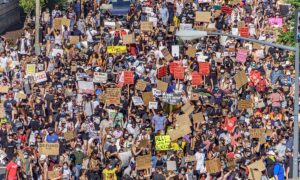
Image credit: Ted Eytan/Flickr – CC BY-SA 2.0
At the end of May, I wrote a piece for Forbes about the outrage people are so quick to feel these days. It began like this:
“We are outraged.
“We are outraged when we see someone without a mask. Outraged when asked to wear a mask. Outraged with every headline. Outraged by every social media comment. Outraged before breakfast. After lunch. During dinner. In our dreams. It’s an epidemic. And I’m convinced our outrage is more destructive than the novel coronavirus.” (read more)
Obviously, I was thinking about pandemic outrage. Boy, what a difference a day can make!
Now outrage is spreading across the country in the form of violence, fires, and looting. There is outrage about the death of George Floyd. Outrage about protesters. Outrage about police treatment of protesters. Outrage about Trump’s tweets. And outrage about instigators. While the stakes seem higher than ever, my “Antidote” advice is unchanged. Start with the facts:
- George Floyd died while an officer kneeled on his neck for nine minutes.
- George Floyd joins a long history of black men and women who have died at the hands of the police in far greater numbers than white people and who have done nothing to bring on that harassment and violence other than being black.
- People are mad. They believe things must change. For real this time, because this has been going on too long.
- The protests began peacefully in Minneapolis and have spread across the country and overseas.
- Most of the protesters have been peaceful, showing solidarity with George Floyd and demanding an end to police brutality.
- Some of the protesters have become violent as their anger has apparently burst its seams.
- Instigators seem to have joined the protests to incite and maximize the violence, looting, fires, and destruction.
- Many ordinary citizens have turned out in the mornings to help clean up and support the small business owners whose property has been damaged or destroyed.
- Our President’s response has been tweets. Tweets which most people would agree have encouraged violence and shown no sympathy for George Floyd or the claims of racial injustice.
- Some police forces have come dressed to fight and appear quick to do so. Others have come without shields and have marched and kneeled alongside protesters.
- Some people say the instigators are left-wing and others say they are right-wing. Few believe they care about George Floyd. Most believe their motivation is do destabilize our country and increase our divisions.
- Minneapolis reacted quickly in firing the four police officers involved, but waited several days before arresting and charging one with murder. The other three, who were seen in videos doing nothing to help George when he repeatedly said he could not breathe, were not initially arrested. Many people think this shows bad faith and a lack of understanding of the problem by the Minneapolis police department.
Are you questioning my objectivity and facts? If so, good for you. You should. Try writing the facts yourself. It is very difficult to do if you hold any opinions about the behavior of anyone involved.
More important, if you question my facts, are you driven to dig deeper and get better information? Or do you simply broadcast your own contrary conclusions and extend your outrage to include me?
We don’t know who is really responsible for the violence. How could we? Not yet, anyway. We don’t know the motivation of instigators. We don’t know how many heartfelt protesters remained peaceful and how many turned violent. We don’t even know for sure if there is any good reason why that cop kept his knee on George’s neck for nine minutes until he died.
The ability to remain calm and dig to find the facts, before you start to react, before you spread false fuel for outrage on social media, before you rage among friends and colleagues, and even before you draw conclusions about an employee, is a skill worth practicing. It will make you a better leader, a better supervisor, a better citizen, a better parent, a healthier person, and a better person.


Comments are closed.